- Faculty News
- Student News
- Lab News
- Publications
- Meetings and Presentations
- Outreach
- Grants
- Announcements
- About This Newsletter
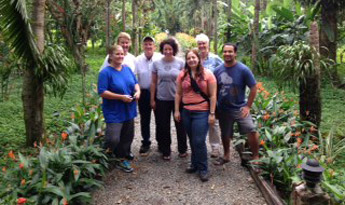
ABOVE: The Tropical Entomology class in Honduras. From left to right: Debbie Matthews, Dr. Jackie Miller, Dr. Ron Cave, Caroline Storer, Sarah Bernard, Anita Neal, and John Zukowski at the Pico Bonito Lodge.
The following faculty were among the awardee's in the 2013 Florida Entomological Society professional awards, announced at the recent meeting in Naples, FL.
- Lance Osborne (Mid Florida REC) Annual Achievement Award for Extension
- Jorge Peña (Tropical REC) Research Team Award with Paul Kendra (USDA-ARS)
- Waldemar Klassen (Tropical REC) received special recognition for his editorship of the Florida Entomologist
 Dr. James Lloyd and Dr. Marc Branham were interviewed on camera for a documentary on fireflies and their conservation. The documentary titled "Brilliant Darkness: Hotaru in the Night" explores firefly conservation from the perspective of nocturnal habitat conservation. It considers the challenges, implications, and significance of night and its crucial role in animal biology and life cycles. This film is presented by the Zoological Lighting Institute, a nonprofit organization supporting wildlife sensitive lighting for wildlife conservation and is directed by Emily Driscoll, the award winning director of "Shellshocked," which was awarded the 2012 Best Short Feature, at the Princeton Environmental Film Festival.
Dr. James Lloyd and Dr. Marc Branham were interviewed on camera for a documentary on fireflies and their conservation. The documentary titled "Brilliant Darkness: Hotaru in the Night" explores firefly conservation from the perspective of nocturnal habitat conservation. It considers the challenges, implications, and significance of night and its crucial role in animal biology and life cycles. This film is presented by the Zoological Lighting Institute, a nonprofit organization supporting wildlife sensitive lighting for wildlife conservation and is directed by Emily Driscoll, the award winning director of "Shellshocked," which was awarded the 2012 Best Short Feature, at the Princeton Environmental Film Festival.
 Dr. Rana I'ncekulak, an Assistant Professor at Ordu University Faculty of Agriculture, in Ordu Turkey, conducted research in the laboratory of Dr. Marjorie Hoy> during 2011. Their joint manuscript,"Evaluation of proxies for quality of Metaseiulus occidentalis (Acari: Phytoseiidae) reared on different stages of Tetranychus urticae (Acari: Tetranychidae)", has been accepted for publication in Biological Control.
Dr. Rana I'ncekulak, an Assistant Professor at Ordu University Faculty of Agriculture, in Ordu Turkey, conducted research in the laboratory of Dr. Marjorie Hoy> during 2011. Their joint manuscript,"Evaluation of proxies for quality of Metaseiulus occidentalis (Acari: Phytoseiidae) reared on different stages of Tetranychus urticae (Acari: Tetranychidae)", has been accepted for publication in Biological Control.
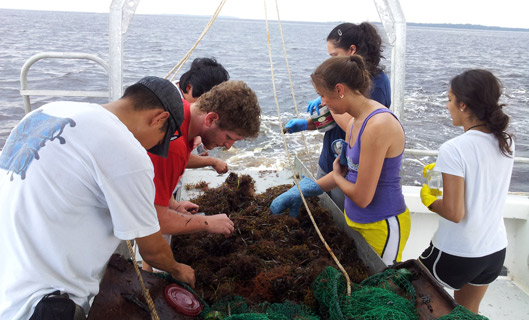
ABOVE: Dr. Akito Kawahara and his students Kenneth Dave Juan, Alexandra Arias, Diana Carolina Salazar, Bryan Karp, Ana Pitocchi and Zik Qianju Jia are shown collecting marine invertebrates on a boat near Seahorse Key for their Invertebrate Field Biology class.
 Masters student Sedonia Steininger (in the Lucky lab) was awarded 1st prize in the Masters student competition for research presentations at the 2013 Annual Meeting of the Florida Entomological Society. Her presentation was entitled "Evaluation of trap types and attractants for large scale monitoring of bark and ambrosia beetles (Curculionidea: Scolytinae and Platypodinae)". Sedonia was awarded a travel grant from the FES to attend this year’s meeting.
Masters student Sedonia Steininger (in the Lucky lab) was awarded 1st prize in the Masters student competition for research presentations at the 2013 Annual Meeting of the Florida Entomological Society. Her presentation was entitled "Evaluation of trap types and attractants for large scale monitoring of bark and ambrosia beetles (Curculionidea: Scolytinae and Platypodinae)". Sedonia was awarded a travel grant from the FES to attend this year’s meeting.
 Tina Gu, Graduate student with Dr. Billy Crow, was selected to participate in the United States Golf Association internship program 8-12 July. Tina spent the week visiting 12 golf courses with Florida's two USGA agronomists, John Foy and Todd Lowe, learning about golf course maintenance and construction, and about the USGA Green Section advisory service. This is a prestigious internship, with only a handful of students selected to participate each year.
Tina Gu, Graduate student with Dr. Billy Crow, was selected to participate in the United States Golf Association internship program 8-12 July. Tina spent the week visiting 12 golf courses with Florida's two USGA agronomists, John Foy and Todd Lowe, learning about golf course maintenance and construction, and about the USGA Green Section advisory service. This is a prestigious internship, with only a handful of students selected to participate each year.
 Ms. Emma Mantyh, a visiting high school student in Dr. James Cuda’s lab, gave an oral presentation and presented a poster to her peers of the 55th Annual Student Science Training program both entitled "The effect of the cold on the emergence of adult Cricotopis lebetis". Emma was supervised by Dr. James Cuda, Dr. Emma Weeks and Ms. Alissa Berro.
Ms. Emma Mantyh, a visiting high school student in Dr. James Cuda’s lab, gave an oral presentation and presented a poster to her peers of the 55th Annual Student Science Training program both entitled "The effect of the cold on the emergence of adult Cricotopis lebetis". Emma was supervised by Dr. James Cuda, Dr. Emma Weeks and Ms. Alissa Berro.

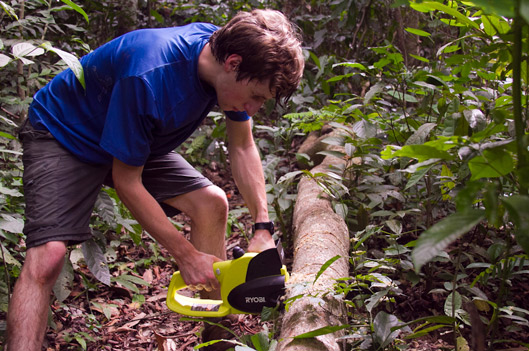
ABOVE: Craig Bateman, an M.S. student studying under Dr. Jiri Hulcr, returned from an ambrosia beetle-fungus collecting trip in China and Thailand. Craig is hoping to learn more about how to predict and manage invasive symbioses by testing if American trees can be harmed by fungi associated with beetles found in Asia.
 Congratulations to our students!
Congratulations to our students!
The CALS Ambassadors are a select group of undergraduate students in the University of Florida's College of Agricultural and Life Sciences who have demonstrated outstanding achievement in academics and student leadership. CALS Ambassadors support food, agriculture and natural resources throughout the state of Florida. Their objective is to create awareness of the academic programs and career opportunities in food, agriculture and natural resources among students, teachers, advisors and the general public in the state of Florida.
James Fleming, Casey Parker, and Sabrina White are students representing us as CALS Ambassadors.
 UF's College of Precollegiate Education and Training hosts the Student Science Training Program each summer, where talented high school students from all over the U.S. come stay at UF and participate in a research project at a laboratory on campus. In addition, these students take an evening seminar of interest to them. These seminars are taught by graduate students.
UF's College of Precollegiate Education and Training hosts the Student Science Training Program each summer, where talented high school students from all over the U.S. come stay at UF and participate in a research project at a laboratory on campus. In addition, these students take an evening seminar of interest to them. These seminars are taught by graduate students.
This year, three Entomology graduate students- Robert Aldridge, Thomson Paris, and Nina Zagvazdina taught an Entomology seminar, which focused on amazing insect sensory systems. They tried to vary the seminar structure to include lecture, discussion, and microscope time.
 Ms. Alissa Berro participated as a co-leader in a Wildlife Ecology and Conservation Department field course titled Coastal Conservation Biology. The 10-day field course based in Cedar Key focuses on basic concepts of conservation biology. Alissa provided the nine students enrolled in the class with an overview of Brazilian peppertree and other exotic plants invading the Cedar Keys Wildlife Refuge.
Ms. Alissa Berro participated as a co-leader in a Wildlife Ecology and Conservation Department field course titled Coastal Conservation Biology. The 10-day field course based in Cedar Key focuses on basic concepts of conservation biology. Alissa provided the nine students enrolled in the class with an overview of Brazilian peppertree and other exotic plants invading the Cedar Keys Wildlife Refuge.
Need to name that bug? A host of experts are available to help Floridians identify any insect or related arthropod. If a mystery creature has six or more legs, the UF Insect ID Lab is the place to call.
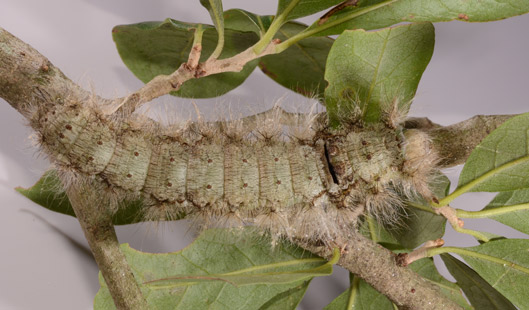 ABOVE: Dr. Howard Frank brought a neat caterpillar that he found in his yard to the lab. It was huge (70 mm long), and ready to pupate. It is Tolype velleda, the large tolype. They feed on leaves of cherry, oak, and other woody plants. During the day they rest on bark, where their color gives them excellent camouflage.
ABOVE: Dr. Howard Frank brought a neat caterpillar that he found in his yard to the lab. It was huge (70 mm long), and ready to pupate. It is Tolype velleda, the large tolype. They feed on leaves of cherry, oak, and other woody plants. During the day they rest on bark, where their color gives them excellent camouflage.
Lyle Buss is the Insect ID Lab manager.
 Think it might be a nematode problem? The Nematode Assay Laboratory serves Florida and other states by providing nematode assays and expert advice regarding nematode management.
Think it might be a nematode problem? The Nematode Assay Laboratory serves Florida and other states by providing nematode assays and expert advice regarding nematode management.
For more information on the Nematode Assay Laboratory please contact the lab manager Dr. Tesfa Mengistu.
Atwater M. 2013. Diversity and nectar hosts of flower-settling moths within a Florida sandhill ecosystem, Journal of Natural History DOI: 10.1080/00222933.2013.791944.
Chen X, Rohrig E, Stansly PA. 2013. Carbon dioxide anesthesia of Tamarixia radiata (Hymenoptera: Eulophidae) parasitoid of Diaphorina citri (Hemiptera: Psyllidae). Florida Entomologist 96: 246-248.
Crow WT, Kenworthy KE. 2013. Integrated pest management of plant-parasitic sting nematodes on bermudagrass. Turfgrass and Environmental Research Online 12: 33.
Grafton-Cardwell EE, Stelinski LL, Stansly PA. 2013. Biology and management of Asian citrus psyllid, vector of the Huanglongbing pathogens. Annual Review of Entomology 58: 413-432.
Hijaz F, El-Shesheny I, Killiny N. 2013. Herbivory by the insect Diaphorina citri induces greater change in citrus plant volatile profile than does infection by the bacterium, Candidatus Liberibacter asiaticus. Plant Signal Behavior 11: 8-10. doi:pii: e25677. [Epub ahead of print]
Johnson DT, Roubos CR, Nyoike TW, Stelinski LL, Liburd OE. 2013. Lures, mating disruption and mass trapping of grape root borer. Acta Horticulturae (ISHS) 1001: 129-137.
McGroary PC, Crow WT, Giblin-Davis RM, McSorley R. 2013. Timing of nematicide applications on turfgrass to reduce damage caused by Belonolaimus longicaudatus. International Turfgrass Society Research Journal 12: 363-367.
Miller CW, Fletcher Jr. RJ, Gillespie SR. 2013. Conspecific and heterospecific cues override resource quality to influence offspring production. PLoS One 8:e70268. doi: 10.1371/journal.pone.0070268
Parker JK, Wisotsky SR, Johnson EG, Hijaz FM, Killiny N, Hilf ME, de la Fuente L. 2013. Viability of 'Candidatus Liberibacter asiaticus' prolonged by addition of citrus juice to culture medium. Phytopathology. [Epub ahead of print]
Quesenberry KH, Kenworthy KE, Crow WT, Harmon PF, Lu H, Milla-Lewis S. 2013. Lance nematode effects on rooting of two St. Augustinegrass cultivars. International Turfgrass Society Research Journal 12: 357-361.
Stratman KN, Overholt WA, Cuda JP, Netherland MD, Wilson PC. 2013. Toxicity of fipronil to the hydrilla midge, Cricotopus lebetis Sublette. Journal of Toxicology and Environmental Health, Part A, 76: 1-7.
Tiwari S, Stelinski LL. 2013. Effects of cyantraniliprole, a novel anthranilic diamide insecticide, against Asian citrus psyllid under laboratory and field conditions. Pest Management Science 69: 1066-1072.
 New on Featured Creatures:
New on Featured Creatures:
Do you have a favorite creature? Learn how to make it into a Featured Creature!Rainbow scarab, Phaneaus vindex Macleay Authors: Thomson Paris, University of Florida, Barukh Rohde, Hunter College, and Phillip Kaufman, University of Florida.
Seedcorn maggot, Delia platura (Meigen) Authors: Harsimran Kaur Gill, Gaurav Goyal and Jennifer Gillett-Kaufman, University of Florida.
Dr. Billy Crow showed off his turfgrass nematicide and cultivar response trials to the Seven Rivers Golf Course Superintendents Association at their informal field day at the PSREU in Citra on 25 July.
 News From the Florida Entomological Society Meeting
News From the Florida Entomological Society Meeting
Dr. James P. Cuda attended the 96th Annual Meeting of the Florida Entomological Society Meeting held in Naples, FL, 14-17 Jul. Dr. Cuda contributed a poster presentation titled, "Preliminary surveys in east Africa for natural enemies of the invasive cogongrass, Imperata cylindrica (Poaceae)".
Dr. Andrea Lucky also attended the FES meeting and presented a research talk entitled: "The School of Ants: using citizen scientist data to map urban biodiversity patterns in Florida".
Doctoral student Scott D. Croxton and Dr. Philip A. Stansly, presented a poster, "Foiling the yellow dragon", and a paper, "Asian citrus psyllid seasonal movement and spatial distribution patterns"; and doctoral student Xulin Chen and Dr. Stansly presented, "The Influence of diet on egg formation in Tamarixia radiata (Waterston) (Hymenoptera: Eulophidae), a parasitoid of Diaphorina citri (Kuwayama) (Hemiptera: Psyllidae)" as her doctorate research.
Research Associate Professor, Dr. Jawwad A. Qureshi, and Dr. Philip A. Stansly, presented their research, "Performance of predatory beetle Cryptolaemus montrouzieri on diets of Asian citrus psyllid Diaphorina citri, citrus mealybug Planococcus citri, green citrus aphid Aphis spiraecola, corn leaf aphid Rhopalosiphum maidis and flour moth Ephestia kuehniella"; Drs. Jawwad A. Qureshi, Azhar A. Khan and Philip A. Stansly, presented "Response of Asian citrus psylla, Diaphorina citri Kuwayama (Hemiptera: Psyllidae) to selected organic insecticides".
Post-doctoral associate, Drs. Cesar Monzo, and Dr. Philip A. Stansly, presented, "Economic Injury Level model for Asian citrus psyllid control in citrus groves with high incidence of HLB". Dr. Moneen Jones and Dr. Philip A. Stansly also provided, "Extension model to improve Asian citrus psyllid control in citrus health management areas", as a paper presentation; Dr. Pilar Vanaclocha and Dr. Philip A. Stansly presented the poster, "The Citrus Greening Bibliographical Database".
 News From the 52nd Annual Meeting of the Society of Nematologists
News From the 52nd Annual Meeting of the Society of Nematologists
The SON annual meeting was held in Knoxville, TN on 14-17 July. Attendees from UF Entomology and Nematology were:
Faculty: Dr. Billy Crow (ENY Dept.), Dr. Don Dickson (ENY Dept.), Dr. Robin Giblin-Davis> (FT. Lauderdale REC), and Dr. Joe Noling (Citrus REC).
Graduate students: Richard Baidoo, Tina Gu, David Sekora, Silvia Vao, Courtney Jackson, Kanan Kutsuwa, Weimin Yuan.
Post Docs/Staff: Dr. Maria Mendes, Dr. Nick Sekora.
UF Presentations:
Baidoo R, Stamps RH, Crow WT. Management of root-knot nematodes (Meloidogyne spp.) on Pittosporum tobira in Florida.
Crow WT. Fluensulfone, a promising nematicide for use on turfgrasses.
Crow WT. The pathogenicity and interactions of Helicotylenchus pseudorobustus in Florida turfgrass systems.
Dickson DW, Mendes ML. Efficacy of MCW-2 on Florida vegetables.
Gu M, Crow WT. Effects of fungicides and insecticides on Belonolaimus longicaudatus.
Kanzaki N, Giblin-Davis RM, Ye W, Herre EA, Center BJ. Redescription of Parasitodiplogaster maxinema with a report of stomatal dimorphism.
Kokalis-Burelle N, Zasada I, Crow WT, LaMondia JA, Stetina SR, Westphal A. Navigating the publication process for the Journal of Nematology.
Mendes M, Dickson DW, Thies JA. Host status of selected pepper genotypes to Meloidogyne floridensis and M. javanica race 3 populations from Florida.
Noling JW, Cody M, Johns D, Lands S, Warren M. Nematode management and soil fumigation research: Prefumigation soil moisture conditions.
Noling JW, Cody M. Summary of methyl bromide alternatives research in Florida strawberries.
Sekora D, Huffaker A, Crow WT, Mekete T. The effect of transgenic endogenous defense elicitors on Arabidopsis on the infection rate and life stage development of root-knot nematodes (Meloidogyne incognita).
Ye W, Giblin-Davis RM. Real-time PCR for species identification of pine wood nematode Bursaphelenchus xylophilus (Nematoda: Parasitaphelenchidae).
We have several social media sites for the Entomology & Nematology Department. To make them easily searchable, all three (YouTube, Facebook and Twitter) have the same page name: UFEntomology. Please share these links with past students or colleagues who may have an interest in departmental activities.
The DPM program would like to invite our newsletter readers to like their Facebook page to keep up with DPM events and developments. Be sure and "like" the DPM Facebook page.
Honey Bee Research and Extension Laboratory invites you to follow them on Twitter to find out about upcoming events and interesting stories about honey bees @UFHoneybeelab.
 Entomology Citizen Science Opportunities for Youth
Entomology Citizen Science Opportunities for Youth
We would like to share some exciting opportunities for youth to engage in Citizen Science. Below are links to four different Citizen Science projects for volunteers and parents to offer to youth.
- Native Buzz
- Project Butterfly Wings
- School of Ants
- Backyard Bark Beetles
What is Citizen Science?
Citizen science asks everyday people to make observations of things like birds, plants and insects and to share their observations with Scientists. Scientists use the data to conduct research on the subject being observed. This helps them to ask more questions, find more answers and learn how environmental changes are affecting different species.
For more information on any one of the Entomology Citizen Science Projects or other Entomology Projects for 4-H youth, contact Dr. Rebecca Baldwin (352-273-3974).
Submitted by: Judy Levings and Ben Knowles
 From the Outreach Coordinator
From the Outreach Coordinator
Dr. James P. Cuda was an invited speaker for the 2013 IFAS/FTGA Great CEU Roundup, July 10th. Cuda gave a polycom presentation titled, “Integrating biological controls and herbicides”. In total, 20 extension offices hosted this statewide distance education workshop.
Dr. James P. Cuda’s lab hosted a group of 21 students and their chaperones as part of the College Reach Out Program (CROP) for disadvantaged students in grades 6-12 during the week of July 14th. CROP is a statewide project intended to increase student participation in postsecondary education.
The live critters are always a hit with children and adults alike. The critters are available for you to check out should you be leading an outreach event. We have doubles of our most popular critters, as well as various native insect species depending on the time of year. We have large wood and Plexiglas cages for viewing our native orb weaving spiders. There is one travel cage and one larger static cage. Please be sure to contact us and review the protocol on transporting and handling the critters if you are not already familiar with it. If you lead an outreach, be sure to fill out a documentation form so your event can be included in the newsletter and we can log all outreach events.
If you would like to schedule an event or have any outreach questions, go to the Outreach pages on our Bug Club Website and contact us. I look forward to working with all of you over the next four years.
- Stephanie Stocks, Outreach Coordinator
- Office number 352-273-3958
Virni Mattson, our Grants Specialist, reports that June 1st to July 31st, 2013, we have had 20 new grants or contracts awarded for a total of $1,300,008.54 in external funding for all Entomology & Nematology faculty (in Gainesville and at RECs).
Dr. James P. Cuda was a co-recipient of a $37,950 grant awarded by the FWC Invasive Plant Management Section. This grant will fund surveys for natural enemies of cogongrass in eastern and southern Africa.
Insect Molecular Genetics, ENY 5820, 3 units, will be offered during Fall 2013 on Mondays during periods 6-8 in 1027 Steinmetz Hall by Dr. M. A. Hoy. The textbook for the course is Insect Molecular Genetics, Third Edition (2013, Academic Press). The course is available by distance, as well, for students at the RECs. Polycom will be available. Please check with Ruth for the section numbers. For additional course information, please contact Dr. Hoy (273-3961).
 2014: International Firefly Symposium
2014: International Firefly Symposium
As the most commonly encountered and widely recognized bioluminescent organism worldwide, fireflies serve as the model system for the study of bioluminescence.
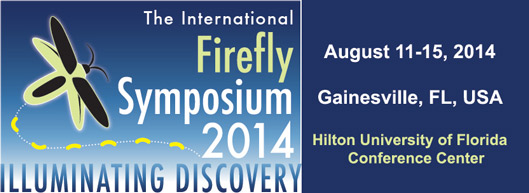
ABOVE: Mark your calendar and make plans to attend the International Firefly Symposium scheduled for August 11-15, 2014, at the University of Florida in Gainesville, Florida, USA.
This international symposium will provide numerous opportunities for participants to share up-to-date information and research and to discuss common concerns and interests, and we invite you to join us.
The Call for Abstracts will be coming out soon. Updates will be posted on the symposium website, so add this link to your favorites and check back periodically.
We like to share news when it happens using our social media outlets: Twitter, Facebook and YouTube. Follow us on these sites for daily updates! When you send news, we will post it on one or more of these sites and again in the monthly newsletter. Please be sure you have permission from people in photographs you submit for publication.
UF-Bugnews-L listserv subscribers receive notices when issues are posted. Our home page has instructions for subscribing and unsubscribing.
Special thanks to Dr. Verena Lietze and Nancy Sanders who reviewed the newsletter for errors and to Jane Medley and Don Wasik who built the web page design.